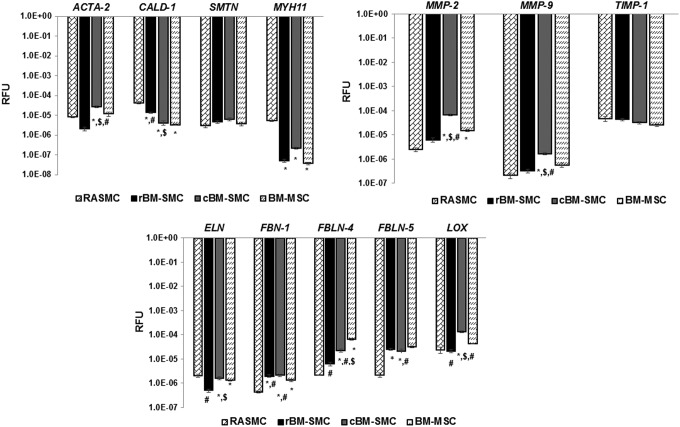Abdominal aortic aneurysms (AAAs) are localized expansions of the stomach aorta that develop slowly to rupture. AAA progress is pushed by irreversible elastic matrix breakdown in the aorta wall by chronically upregulated matrix metalloproteases (MMPs).
Since grownup vascular easy muscle cells (SMCs) poorly regenerate elastic matrix, we beforehand explored utility of bone marrow mesenchymal stem cells and SMCs derived therefrom (BM-SMCs) for this function.
One particular differentiated phenotype (cBM-SMCs) generated on a fibronectin substrate in presence of exogenous reworking progress factor-β and platelet-derived progress issue exhibited superior elastogenicity versus different phenotypes, and usefully offered proelastogenic and antiproteolytic stimuli to aneurysmal SMCs.
Since in vivo cell remedy calls for giant cell inoculates, these derived SMCs should be propagated in vitro whereas sustaining their superior elastogenic, proelastogenic, and antiproteolytic traits. In this work, we thus investigated the tradition situations that should be offered to this propagation part, which be sure that the differentiated SMCs preserve their phenotype and matrix regenerative advantages.
Our outcomes point out that our BM-SMCs retain their phenotype in long-term tradition even in the absence of differentiation progress components and fibronectin substrate, however these situations should be continued to be offered throughout postdifferentiation propagation if they’re to keep up their superior elastic matrix deposition, crosslinking, and fiber formation properties.
Our examine, nonetheless, confirmed that cells propagated underneath these situations exhibit larger expression of MMP-2, however favorably, no expression of elastolytic MMP-9.
Hence, the examine outcomes present essential pointers to keep up phenotypic stability of cBM-SMCs throughout their propagation in two-dimensional tradition earlier than their supply to the AAA wall for remedy.

Sub-toxic publicity to lindane prompts redox delicate kinases and impairs insulin signaling in muscle cell tradition: The attainable mechanism of lindane-induced insulin resistance.
Lindane publicity is claimed to be concerned in pathogenesis of sort 2 diabetes mellitus (T2DM) and insulin resistance state by an as but unknown mechanism. The redox delicate kinases (RSKs) and warmth shock proteins (HSPs) intrude with insulin signaling and induce insulin resistance.
The current examine was designed to discover the mechanism of insulin resistance induced by sub-toxic lindane publicity. In an in vitro examine, publicity to 60 mg/L and 120 mg/L of lindane for 18 h on rat L6 myoblasts derived myotubes considerably elevated malondialdehyde degree & superoxide dismutase exercise, decreased complete antioxidant degree and insulin-induced glucose uptake in a dose dependent method.
The extent of activation of RSKs and HSP25 as measured by western blot from the extent of phosphorylation of IκBα, p38 MAPK, JNK & HSP25 in lindane-exposed myotubes was larger. HSP70 was induced and insulin signaling as measured from tyrosine phosphorylation of insulin receptor (IR) & insulin receptor substrate-1 (IRS-1) and serine phosphorylation of Akt was attenuated in comparability to these in untreated myotubes.
We conclude that sub-toxic lindane publicity induces oxidative stress, prompts RSKs & HSP25 and induces HSP25. These in flip, impair insulin signaling to impart insulin resistance in myotubes induced by sub-toxic lindane publicity.

